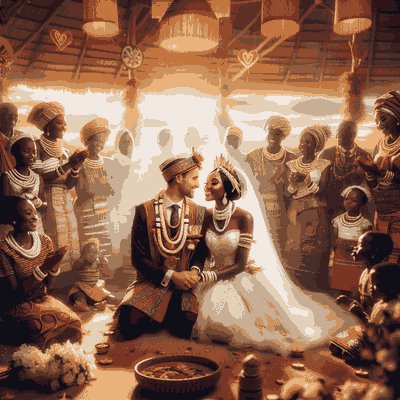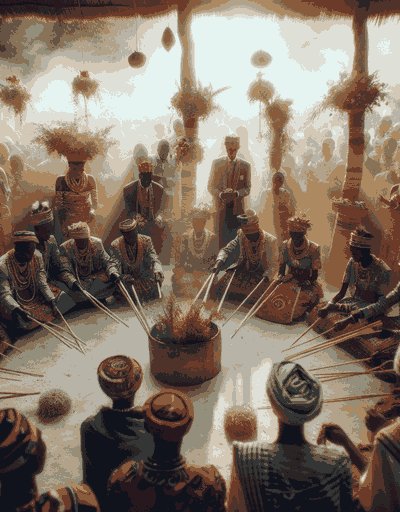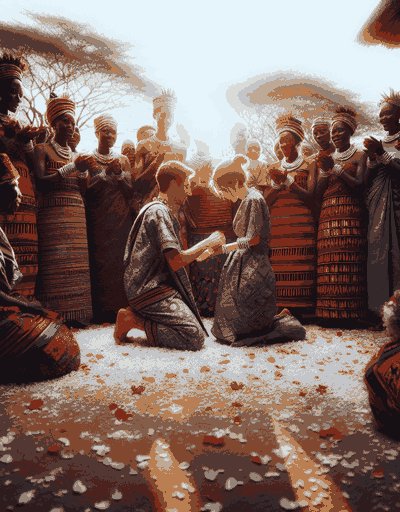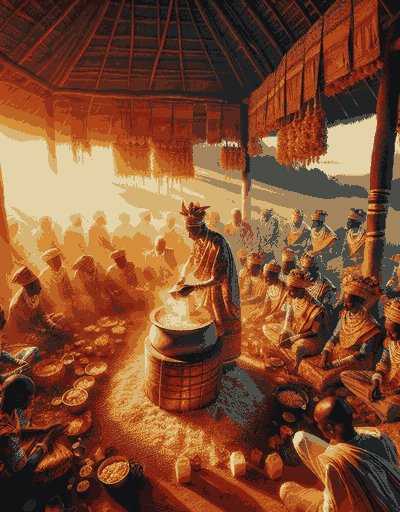Malawi Wedding Traditions Cultural Wedding Guide 2025
Malawian wedding traditions are elaborate multi-day celebrations combining Christian ceremonies, tribal customs, and community festivities that typically involve 200-500 guests and cost between $2,000-$10,000 USD. These traditions encompass pre-wedding negotiations like lobolaloh-BOH-lah, the traditional Chinkhoswechin-KOH-sway ceremony, church weddings, and distinctive reception customs including monetary gift-giving dances, creating celebrations that last 2-3 days and unite entire communities.

Overview of Malawian Wedding Process

- Pre-Wedding Phase (3-12 months): Family meetings, lobolaloh-BOH-lah negotiations ($500-$5,000 USD), Chinkhoswechin-KOH-sway ceremony
- Wedding Day: Morning church ceremony (2-3 hours), afternoon reception (6-8 hours)
- Key Participants: 10-20 bridal party members, 200-500 guests, designated cashiers, master of ceremony
- Total Cost Range: $2,000-$10,000 USD in urban areas, $500-$3,000 USD in rural areas
- Duration: Full celebrations typically span 2-3 days including pre-wedding events
Pre-Wedding Traditions and Ceremonies

What is Lobola in Malawian Culture?
Lobolaloh-BOH-lah is the traditional bride price payment in Malawi where the groom’s family pays 3-10 cattle (or $500-$5,000 USD cash equivalent) to the bride’s family, symbolizing respect and the groom’s ability to provide. This centuries-old practice involves formal negotiations led by the groom’s uncle and varies significantly by region - northern regions require minimum 3 cattle while southern regions may accept alternative wealth like goats, chickens, or land.
Lobola Components by Region:
- Northern Malawi: 3-10 cattle minimum ($1,500-$5,000 USD)
- Central Malawi: 5-8 cattle plus return gifts ($2,500-$4,000 USD)
- Southern Malawi: Mixed livestock or cash ($500-$3,000 USD)
- Urban Areas: Primarily cash payments adjusted for bride’s education
According to local wedding planners, educated brides with university degrees command 30-50% higher lobola payments. Despite criticism, 85% of Malawian marriages still include lobola negotiations.
Traditional Chinkhoswe Engagement Ceremony
Chinkhoswechin-KOH-sway is the traditional Malawian engagement ceremony that serves as the customary marriage, occurring 3-12 months before any church wedding and involving 50-150 family members. This indoor ceremony features the symbolic exchange of a rooster (tambalatahm-BAH-lah - NY-MW_tambala) representing the groom and a hen (nkhukun-KOO-koo - NY-MW_nkhuku) representing the bride, or alternatively matching chitenjechi-TEN-jay fabric.
Chinkhoswe Ceremony Elements:
- Duration: 4-6 hours
- Participants: 50-150 extended family members
- Cost: $200-$1,000 USD for venue, food, and symbolic items
- Key Components: Animal exchange, marriage counseling, family introductions
- Traditional Counseling: 2-3 hour session for bride on maintaining household harmony
Pre-Wedding Celebrations and Preparations
Pre-wedding celebrations in Malawi occur the night before the wedding, featuring gender-separated activities where women prepare food for 200-500 guests while men socialize, with music playing throughout the night. This tradition costs families $300-$800 USD for ingredients and involves 20-40 women cooking traditional dishes.
Regional Pre-Wedding Variations:
- Chewa people: Purification rituals and ancestor prayers
- Northern tribes: Elder-led counseling sessions (mphunzitsim-poon-ZIT-see - NY-MW_mphunzitsi)
- Southern regions: Community dancing competitions
- Urban areas: Combined with bachelor/bachelorette parties
Wedding Ceremony Traditions

Civil and Church Wedding Requirements
Malawian civil marriage requires couples to obtain a government marriage certificate before or after their religious ceremony, with 78% of couples choosing morning church weddings officiated by priests or pastors. These ceremonies typically last 2-3 hours and cost $500-$2,000 USD including venue, decorations, and officiant fees.
Church Wedding Statistics:
- Timing: 85% occur between 9 AM - 12 PM
- Guest attendance: 150-400 people
- Ceremony duration: 2-3 hours
- Popular months: April-September (dry season)
Wedding Attire and Chitenje Coordination
Chitenjechi-TEN-jay is the traditional colorful fabric worn by 90% of Malawian wedding parties, with coordinated outfits costing $20-$50 USD per person. Brides typically wear white wedding dresses ($200-$1,500 USD) for church ceremonies, then change into chitenje-based outfits for receptions.
Attire Investment Breakdown:
- Bride’s dress: $200-$1,500 USD (purchased or rented)
- Groom’s suits: $150-$500 USD (often two suits)
- Bridal party chitenje: $300-$800 USD total
- Family coordination: $200-$500 USD
Traditional Wedding Tests and Rituals
Identification tests are traditional Chewa rituals where the groom must identify his bride from among 5-10 similarly dressed women, and the bride’s uncle must identify the groom from his friends. These lighthearted challenges occur at 45% of traditional weddings, particularly in central Malawi.
Test Variations by Tribe:
- Chewa: Visual identification from lineup
- Tumbuka: Knowledge questions about partner
- Yao: Physical strength demonstrations
- Lomwe: Dancing skill displays
Reception and Celebration Traditions
The Master of Ceremony Role
The Master of Ceremony (bwana wamkuluBWAH-nah wahm-KOO-loo - NY-MW_bwana-wamkulu) is an essential figure at Malawian weddings who coordinates the 6-8 hour reception program, introduces 10-20 wedding party members, and manages gift-giving ceremonies. Professional MCs charge $100-$300 USD while family members often serve without fee.
MC Responsibilities Timeline:
- Hour 1-2: Guest arrival and seating
- Hour 2-3: Bridal party entrance and introductions
- Hour 3-5: Meal service and speeches
- Hour 5-8: Gift-giving ceremony and dancing
Monetary Gift-Giving Dance Tradition
The money dance is Malawi’s most distinctive wedding tradition where 200-500 guests approach the couple in groups, dancing while showering them with cash totaling $500-$5,000 USD. Official cashiers (ochita ndalamaoh-CHEE-tah n-dah-LAH-mah - NY-MW_ochita-ndalama) track all monetary gifts in designated baskets.
Money Dance Statistics:
- Average gift per guest: $2-$20 USD
- Total collection range: $500-$5,000 USD
- Duration: 2-4 hours
- Group size: 5-15 people per dance
- Popular currencies: Malawian Kwacha, USD, GBP (from diaspora)
According to wedding cashiers, smaller denominations like $1 bills are preferred as they create more visual impact during the dance. Groups often coordinate matching chitenjechi-TEN-jay outfits for their presentation.
Traditional Wedding Feast
Malawian wedding feasts feature nsiman-SEE-mah maize porridge and freshly slaughtered meat serving 200-500 guests at a cost of $3-$8 USD per person. Traditional protocol involves multiple food services - first at family homes, then at the reception venue.
Typical Menu Components:
- Nsima: 50-100 kg for 300 guests
- Meat: 2-3 cows, 5-10 goats, or 50-100 chickens
- Side dishes: Vegetables, beans, rice
- Beverages: Soft drinks, traditional drinks
- Modern additions: Wedding cake ($50-$300 USD)
Post-Wedding Traditions
Gift Collection and Household Setup
Post-wedding gift management involves displaying and cataloging household items worth $200-$1,000 USD including cooking pots, dishes, and furniture contributed by 50-200 guests. The bride’s party often sells additional items to raise $100-$500 USD for the couple.
Common Gift Categories:
- Kitchen items: 60% of gifts
- Bedroom furnishings: 20% of gifts
- Monetary contributions: 15% of gifts
- Miscellaneous household: 5% of gifts
Marriage Integration Customs
Family integration after Malawian weddings involves specific protocols including new terms of address (mlamum-LAH-moo - NY-MW_mlamu for in-laws), extended visits lasting 1-4 weeks, and participation in family ceremonies. Traditional expectations include the new wife preparing meals for her husband’s family within the first week.
Integration Timeline:
- Week 1: Initial family visits and meal preparation
- Month 1: Learning family protocols and preferences
- Month 1-3: Establishing household routines
- Month 6: Full integration into extended family events
Regional and Tribal Variations
Northern Region Wedding Customs
Northern Malawian weddings among the Tumbuka, Ngoni, and Tonga peoples feature reverse lobolaloh-BOH-lah where brides sometimes pay 1-3 cattle to grooms, with celebrations involving 300-500 guests. Education significantly impacts bride price - university graduates command 50-100% higher payments.
Northern Statistics:
- Population practicing: 15% of Malawi (2.8 million people)
- Average lobola: 3-10 cattle ($1,500-$5,000 USD)
- Wedding size: 300-500 guests
- Celebration duration: 2-3 days
Central Region Chewa Traditions
Chewa wedding traditions practiced by 35% of Malawians (6.5 million people) feature elaborate identification tests, rooster/hen exchanges, and specialized counseling rituals costing $300-$800 USD additional to standard wedding expenses.
Chewa Distinctive Elements:
- Identification test participants: 5-10 people
- Counseling duration: 3-4 hours
- Special dances: Chimtalichim-TAH-lee
- Additional ceremonies: Ancestor acknowledgment
Southern Region Customs
Southern Malawian weddings among Yao, Lomwe, and Sena peoples (40% of population) accept diverse lobola payments including land rights, feature 4-6 hour gift exchanges, and incorporate Islamic elements in Yao communities.
Southern Variations:
- Yao Muslims: Nikah ceremonies, gender-separated celebrations
- Lomwe: Extended dancing competitions
- Sena: River blessing ceremonies
- Mixed traditions: Christian-Islamic fusion events
Modern Adaptations and Wedding Costs
Contemporary Wedding Budget Breakdown
Modern Malawian weddings cost $2,000-$10,000 USD in urban areas with professional services, while rural celebrations range $500-$3,000 USD relying on community support. Urban couples spend 6-18 months saving for weddings.
Detailed Cost Analysis:
| Category | Urban Cost (USD) | Rural Cost (USD) | % of Budget |
|---|---|---|---|
| Lobolaloh-BOH-lah | $1,000-$5,000 | $500-$2,000 | 25-40% |
| Venue & Decoration | $500-$2,000 | $100-$500 | 15-20% |
| Food & Beverages | $600-$2,500 | $200-$800 | 20-25% |
| Attire | $400-$2,000 | $150-$500 | 10-15% |
| Photography/Video | $200-$800 | $50-$200 | 5-10% |
| Transportation | $150-$500 | $50-$150 | 3-5% |
| Miscellaneous | $150-$700 | $50-$200 | 5-7% |
Professional Wedding Services Growth
Malawi’s wedding industry has grown 200% since 2010 with professional planners charging $300-$1,000 USD, photographers $200-$800 USD, and decorators $300-$1,500 USD per event. Urban areas have 50+ wedding service providers while rural areas rely on 5-10 regional vendors.
Service Provider Statistics:
- Event planners: 30+ in major cities
- Professional photographers: 100+ nationwide
- Catering services: 50+ formal providers
- Venue options: 200+ dedicated spaces
Technology and Social Media Impact
Digital integration in Malawian weddings includes 65% of couples using WhatsApp invitations, 80% hiring professional photographers, and 40% live-streaming ceremonies for diaspora family. Social media sharing occurs at 75% of urban weddings.
Technology Adoption Rates:
- Digital invitations: 65% urban, 20% rural
- Professional photography: 80% urban, 40% rural
- Social media announcements: 75% urban, 30% rural
- Live streaming: 40% urban, 10% rural
Traditional vs Modern Comparison
| Aspect | Traditional Practice | Modern Adaptation | Adoption Rate |
|---|---|---|---|
| Lobolaloh-BOH-lah Payment | 3-10 cattle | $500-$5,000 cash | 85% cash |
| Ceremony Venue | Family compound | Hotels/gardens | 60% venues |
| Guest List | Entire village (500+) | Invited only (200-300) | 70% limited |
| Food Preparation | Family cooking | Professional catering | 40% catered |
| Documentation | Oral tradition | Photo/video | 80% documented |
| Duration | 3-4 days | 1-2 days | 65% shortened |
| Invitations | Word of mouth | Digital/printed | 60% modern |
Cultural Significance and Symbolism
What Do Malawian Wedding Symbols Represent?
Wedding symbolism in Malawi includes the rooster representing male virility and protection, the hen symbolizing female fertility and nurturing, chitenjechi-TEN-jay fabric demonstrating unity, and monetary gifts ensuring prosperity. These symbols appear in 95% of traditional ceremonies.
Symbol Meanings:
- Rooster/Hen: Fertility and gender roles
- Chitenje patterns: Family unity and identity
- Money shower: Community support and prosperity
- White dress: Christian influence and purity
- Traditional foods: Ancestral connections
Marriage as Community Institution
Malawian marriages unite average networks of 200-500 people through extended family connections, with wedding attendance considered a social obligation fulfilled by 90% of invited guests. Community support includes contributing labor, food, or money to 80% of local weddings.
Community Participation Metrics:
- Average guest attendance rate: 90%
- Family members involved in planning: 20-40 people
- Community labor contributions: 30-50 people
- Financial contributors: 100-300 people
How much does a typical Malawian wedding cost?
Malawian weddings cost between $2,000-$10,000 USD in urban areas and $500-$3,000 USD in rural areas. The largest expenses are lobolaloh-BOH-lah25-40% of budget, venue and food (35-45%), and attire (10-15%). Urban couples typically save for 6-18 months before their wedding.
What is the significance of chitenje in Malawian weddings?
Chitenjechi-TEN-jay is the traditional fabric that creates visual unity at Malawian weddings, with coordinated outfits for the 10-20 member bridal party costing $20-50 USD per person. This colorful fabric symbolizes family unity and cultural identity, with 90% of weddings featuring chitenje coordination.
How long do Malawian wedding celebrations last?
Malawian wedding celebrations typically span 2-3 days including pre-wedding preparations, the ceremony day lasting 8-12 hours, and post-wedding family gatherings. Urban weddings are increasingly condensed to 1-2 days while rural celebrations maintain the traditional 3-4 day duration.
What happens during the money dance at Malawian weddings?
The money dance involves 200-500 guests approaching the couple in groups of 5-15 people, dancing while showering them with cash totaling $500-$5,000 USD. Official cashiers track gifts while each group dances for 3-5 minutes to music of their choice.
Is lobola still practiced in modern Malawi?
Lobola remains practiced in 85% of Malawian marriages, though payment has shifted from cattle to cash equivalents of $500-$5,000 USD. Northern regions maintain stricter requirements while urban areas show more flexibility in negotiations.
What role does religion play in Malawian weddings?
Religion significantly influences Malawian weddings with 78% including Christian church ceremonies and 15% incorporating Islamic nikah rituals. Most couples combine religious ceremonies with traditional customs like Chinkhoswechin-KOH-sway, creating dual-ceremony weddings.
How do Malawian weddings differ by region?
Regional differences include northern reverse lobola practices, central Chewa identification tests, and southern acceptance of diverse payment forms. Urban weddings average 200-300 guests while rural celebrations involve 300-500 participants from entire villages.
What is Chinkhoswe and why is it important?
Chinkhoswe is the traditional engagement ceremony serving as customary marriage, involving 50-150 family members and costing $200-$1,000 USD. This 4-6 hour ceremony includes symbolic animal exchanges and marriage counseling, occurring 3-12 months before church weddings.
How has modernization affected Malawian wedding traditions?
Modernization has transformed payment methods (85% cash lobola), venue choices (60% professional venues), and celebration duration (65% shortened to 1-2 days) while maintaining core traditions like money dances, family negotiations, and chitenje coordination.
What should international guests expect at a Malawian wedding?
International guests should expect 8-12 hour celebrations, participating in money dances with $10-$50 USD gifts, traditional foods like nsiman-SEE-mah, coordinated chitenje attire, and extensive dancing. Most urban weddings provide English translation for non-Chichewa speakers.
Frequently Asked Questions
What is Lobola in Malawian wedding traditions?
Lobola is the traditional bride price paid by the groom's family to the bride's family, typically ranging from 3-10 cattle ($1,500-$5,000) depending on the region and family circumstances.
How much does a typical Malawian wedding cost?
Urban Malawian weddings typically cost $2,000-$10,000 USD, while rural celebrations range from $500-$3,000 USD, including all ceremonies and festivities.
What is the Chinkhoswe ceremony?
Chinkhoswe is the traditional engagement ceremony involving symbolic exchanges between families, customary counseling, and formal recognition of the union.
How long do Malawian wedding celebrations last?
Traditional Malawian weddings typically span 2-3 days, including pre-wedding events, the main ceremony, and reception celebrations.
What is the money dance tradition in Malawian weddings?
The money dance is a reception tradition where guests approach the couple in groups, dancing and presenting cash gifts totaling $500-$5,000.
What do Malawian brides typically wear?
Brides usually wear white wedding dresses ($200-$1,500) for the ceremony and change into traditional chitenje-based outfits for the reception.
How many guests attend a typical Malawian wedding?
Malawian weddings typically host between 200-500 guests, with northern region celebrations tending toward larger gatherings.
What role does the Master of Ceremony play?
The MC (bwana wamkulu) coordinates the 6-8 hour reception program, manages introductions, and oversees gift-giving ceremonies.
How are modern technologies incorporated into traditional weddings?
65% of couples use digital invitations, 80% hire professional photographers, and 40% live-stream their ceremonies for distant relatives.
What are the main regional differences in Malawian weddings?
Northern regions practice reverse lobola and larger celebrations, central regions emphasize identification tests, and southern regions incorporate Islamic influences and varied lobola customs.